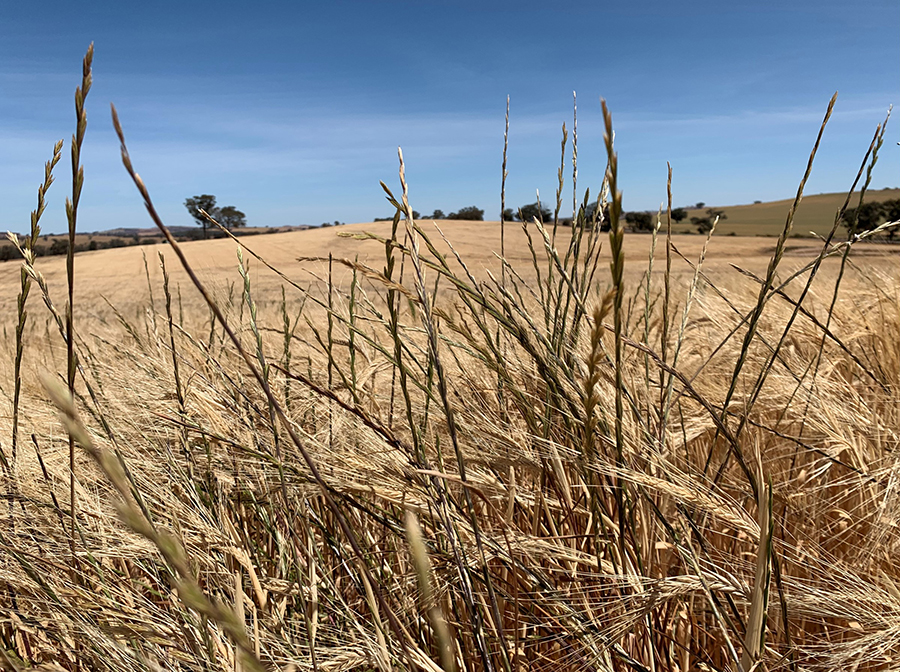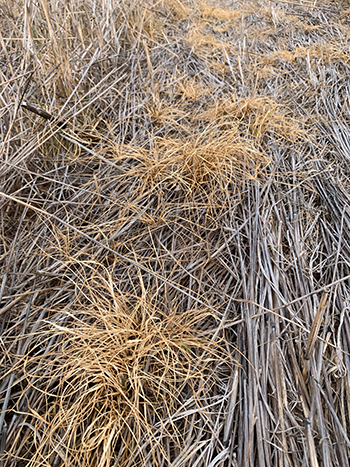In brief
- Annual ryegrass blowouts need swift, diverse and sustained attention
- Advisers encourage targeting 99.9 per cent annual ryegrass control
- WeedSmart’s ‘Big 6’ is a helpful framework for weeds management
- Diverse farming systems that incorporate double breaks and pasture phases help to reduce annual ryegrass populations
Annual ryegrass was the most-common weed concern of those who attended a recent Crop Protection Forum.
The forum, held late last year in Wagga Wagga, New South Wales, enabled advisers and scientists to share their most-recent observations and findings in weed, insect and disease management.
A key theme was the importance of using diverse control strategies to ensure the long-term use of available pesticides.
The one-day forum, run with GRDC co-investment, included presentations from WeedSmart agronomists and researchers from Cesar Australia, the University of Melbourne, the New South Wales Department of Primary Industries, the University of Sydney, the University of Adelaide, the Centre for Crop and Disease Management and the Australian Herbicide Resistance Initiative.
Panel sessions included input from agronomists from companies including Grass Roots Agronomy, Brill Ag, Rural Management Strategies, Delta Agribusiness, Summit Ag Agricultural Consulting, and Nutrien Ag Solutions.
Weeds management
WeedSmart agronomist Jana Dixon, who works in South Australia as a consultant with Pinion Advisory, was one of several presenters who reiterated the importance of using an integrated approach to weed management.
She encouraged the use of WeedSmart’s ‘Big 6’ framework, which promotes:
- rotating crops and pastures;
- mixing and rotating herbicides;
- improving crop competition;
- making use of the double-knock;
- stopping weed seed-set; and
- using harvest weed seed control.
Ms Dixon said herbicide resistance testing and controlling weeds along fence lines were also vital to minimise issues in crops.
“Weed management should be seen as a journey that focuses on fewer weeds and more profit, with the ideal goal to be not allowing weed burdens to influence our rotation decisions going forward,” she said.
“The journey, however, is not always a straight line, as seasons will influence how close we come to reaching our goal.”
She said 2022 resulted in annual ryegrass blowouts in SA and Victoria, on the back of three consecutive wet years. Such conditions led to:
- high weed seed set;
- trafficability and timeliness issues;
- waterlogging and drainage problems; and
- poor crop competition against weeds.
Other challenges included:
- poor harvest weed seed control (HWSC) due to delayed harvesting or deciding not to use HWSC strategies;
- delayed harvesting;
- glyphosate resistance;
- prolonged periods of weed germination; and
- lack of hay options.

Annual ryegrass escapes in a barley crop from season 2022. Photo: Jana Dixon
Accordingly, she said the significant annual ryegrass blowouts of 2022 were likely to carry over to 2023 and beyond.
Going forward, she encouraged:
- stacking weed management tactics;
- ranking paddocks for weed severity; and
- long-term rotation planning.
“Ranking paddocks focuses attention on areas of the farm that are more challenging in terms of weeds and prioritising control to 99.9 per cent,” she said.
“Don’t just think about what you’ll do this year or next, plan the rotation across three to five years with best-practice weed control in mind.
“We often think rotation is the biggest lever we can pull when it comes to weed management, but don’t forget there are five other strategies that can be stacked to manage weed seed escapes.”
Control successes
Ms Dixon also spoke about some of the methods high-rainfall growers in south-western Victoria and south-eastern SA had used to reduce weed numbers.
 Double or triple knocks of glyphosate followed by paraquat continue to be critical for managing glyphosate resistance in annual ryegrass. Photo: Jana Dixon
Double or triple knocks of glyphosate followed by paraquat continue to be critical for managing glyphosate resistance in annual ryegrass. Photo: Jana Dixon
“In these areas, annual ryegrass can germinate just about all year,” she said. “Weeds in these areas can be difficult to control when trafficability is an issue in wet weather. But the power of a double or triple-break phase for annual ryegrass management cannot be rivalled.”
By way of example, she pointed to a nine-year trial led by Professor Chris Preston, from the University of Adelaide, which demonstrated the value of a double break to drive down annual ryegrass numbers.
Ms Dixon also highlighted the merit of having a mixed-farming system to assist with weed management.
“For growers in south-western Victoria who have highly glyphosate-resistant weed populations, sowing paddocks to improved pasture and fodder crops has been a help,” she said. “It has also added diversity and risk management to growers’ businesses.”
Nonetheless, she said such systems called for strong management and effective implementation to ensure a win-win for cropping and livestock.
Although there can be compromises in mixed farming, she said a pasture phase could be followed by two break crops to really drive down the population of problem weeds.
Crop competition
Ms Dixon said crop competition was just as important for growers in high-rainfall areas as it was for growers in medium and low-rainfall areas.
She again pointed to Professor Preston’s work, which demonstrated that it was false economy for high-rainfall growers to put up with high weed populations just because their grain yields might also be high.
“It is critical to do whatever you can to ensure crops are as competitive as possible because annual ryegrass will cost you money through lost yield,” she said.
“For every three annual ryegrass plants per square metre, there is a one per cent decrease in wheat yield. One per cent of a high wheat yield adds up, which is why you can afford to spend money on more-expensive herbicides in medium and high-rainfall areas.
“Aim to plant competitive crops and varieties and carry out soil amelioration works by adding gypsum and completing drainage work to overcome waterlogging.
“Anywhere a crop struggles to grow through the soil because of structural, pH or nutrient constraints, annual ryegrass blows out.”
Ms Dixon said sowing crops on narrow rows and using HWSC were two other useful tools. Additionally, she said, increasing the sowing rate to achieve robust plant populations produced a notable reduction in annual ryegrass seed entering the seedbank.
“Using all of these weed management tactics will add up, especially if you are dealing with a big annual ryegrass population,” she said. “And crop competition is key in any farming system.”
Testing a must
When weed escapes are discovered, Ms Dixon encouraged the use of herbicide resistance testing to determine the active ingredients that work.
“Pre-emergent mixtures are a highly effective tool in high-rainfall areas, especially if they provide residual control from when annual ryegrass is germinating to later in its life cycle,” she said.
“Aggressive strategies to manage annual ryegrass will pay off, especially when you’re dealing with high numbers of plants and seeds in the soil.”
Glyphosate use
When it comes to improving the effectiveness of glyphosate, Ms Dixon encouraged the use of robust water rates, effective coverage, buying reputable branded glyphosate and simplifying tank mixes to reduce antagonism.
“For autumn knockdowns, follow the glyphosate application with paraquat, a Group 14 spike, and a robust pre-emergent herbicide to control surviving plants,” she said.
“Mechanical disturbance is also useful if you are incorporating lime because it can help bury stubborn surviving weeds.”
Weed destruction
During the most recent round of GRDC harvester forums, Ms Dixon said in high-rainfall areas such as Millicent and Keith, in SA, and Hamilton and Inverleigh, in Victoria, growers indicated they were buying mills for HWSC.
“Wetter environments that produce big crops can make HWSC more challenging, but growers are having a go and reporting great success, especially when coupling HWSC with windrowing canola, beans and barley, and with wheat planted on narrow row spacings,” she said.
“There are still problems with green material causing blockages and compromises with capacity, but their work is promising.”
Farming systems
She also pointed to farming systems research led by CSIRO Agriculture and Food chief research scientist Dr John Kirkegaard that demonstrated:
- double-break sequences were highly effective in reducing annual ryegrass and were among the most profitable;
- single-break sequences were only effective in reducing the annual ryegrass population if combined with aggressive management (such as expensive herbicide options);
- in continuous wheat (and wheat/canola) sequences, aggressive control is effective but expensive;
- one year of conservative weed management will lead to a blowout in the population;
- diverse farming systems can be profitable while also carrying lower risk; and
- compared with the baseline (canola/wheat/barley), diverse systems with legumes were:
- more profitable;
- less risky;
- characterised by stable or declining numbers of weeds and diseases; and
- more robust in the long term.
More information: Jana Dixon,jdixon@pinionadvisory.com
Useful resources
Watch
Jana Dixon’s WeedSmart talk at the Crop Protection Forum
Read
Survey prompts fresh call to use multiple weed management tactics.

























































